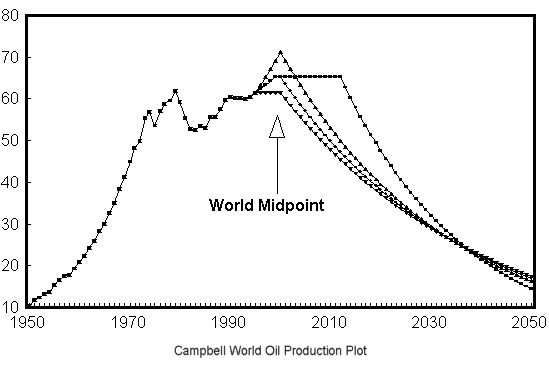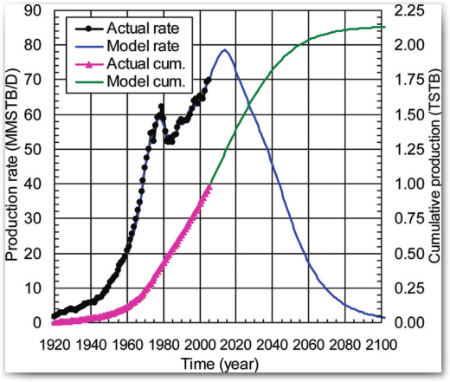Startling New Research Says Peak Oil May Happen by 2014 – Earlier than Many Estimated – By Guest Blogger Kathy

In a surprising announcement in March 2010, Dr. Ibrahim Nashawi of Kuwait University and colleagues released a study that suggests that world conventional crude oil will peak as early as 2014 — a decade or three earlier than other parties have estimated. The findings were published in the American Chemical Society’s magazine Energy & Fuels.
The term “Peak Oil” refers to the point in time when global production has reached its maximum and will start to decline (represented by a bell curve) — thus having bearing on the point at which the oil supply being pulled from earth will not meet oil demand and consumption. Peak Oil is about production of a finite, nonrenewable energy source which is subject to depletion. In fact, oil production has grown almost every year of the last century.
What is Peak Oil?

The chart below illustrates the Peak Oil concept, courtesy of Swenson Campbell:
The Kuwait Study Built Upon Hubbert’s Model
The Kuwaiti team built their research on Hubbert’s model, but brought in factors that have amplified over the time. His model, they say, doesn’t account for more complex oil production cycles of some countries which can be influenced by politics, technology and other factors. The team points out that rapid growth in global oil consumption made it important to update the prediction and modeling process. Their new version updates Hubbert’s single-cycle model to a multi-cycle version. The research team evaluated and studied 47 major oil producing countries of conventional oil. Production trends and known reserves of these top countries were used in the modeling. A chart is found below, courtesy of Dr. Nashawi’s report:
The study projects that world oil production will peak in 2014, and OPEC production should peak by 2026.
Peak Oil and the Future
Peak oil is of concern to the entire developed world, in which the use of petroleum is deeply ingrained — and to the developing world, in which oil is essential for growth. Oil provides about an average of 40% of the global energy (higher use in some countries, lower in others) – and more than 90% of transportation energy. The U.S. has about 2 percent of the world’s oil reserves but consumes about 25 percent.
Oil has tremendous energy density. Roscoe Bartlett, a scientist and U.S. Congressman (R-MD) who is heavily involved in energy studies, has often been quoted as saying that one barrel of energy supplies the same power as 12 people working full-time for a year, or about 25,000 hours of manpower.
We often focus on oil’s importance in the industrial and transportation sectors, but as CNN reported, up to 20 percent of the country’s fossil fuel consumption goes to the food chain. Feeding an average family of four in the developed world requires up the equivalent of 930 gallons of gasoline a year – just shy of the 1,070 gallons that same family would use up each year to fuel their cars. (CNN. “All About Food & Fossil Fuels”, by Rachel Oliver. March 17, 2008).
The fact of Peak Oil really means that we need to confront the situation of diminishing and more expensive oil in our future. How we will deal with it, as individuals, communities and countries?
Right now only about 7% of all our energy needs in the U.S. are met by renewable sources. Although this number is sure to grow with the current stimulus funding and development projects, it still falls far short of where we need to go. Most of renewable energy at this point is targeted at generating electricity, and while many sources for renewables are abundant and free (wind, air, waves), the implementation to date is not as effective and inexpensive.
Other Studies and Reports
There have been many reports over the decades addressing Peak Oil. These include commissioned reports such as the 2005 “Hirsch Report”, as it became known; the National Energy Policy’s report in 2001; studies done by the Association of the Study of Peak Oil, those by universities and researchers; and the new study recently published called “Tipping Point: Near-Term Systemic Implications of a Peak in Global Oil Production” from Feasta, the Foundation for the Economics of Sustainability in Ireland (March 15, 2010 report). The data is available, presented, and understood – but has not garnered much attention in this country, in my opinion, nor has helped any substantial calls to action.
Even folks not traditionally trained in oil, like Sir Richard Branson, have warned of the coming oil crunch. In February 2010, the founder of Virgin announced that he believes the coming oil crisis will be here in five years. He and other British industrialists are calling on their government to act now and prepare. “Don’t let the oil crunch catch us out in the way that the credit crunch did,” he said. (The Guardian. “Branson Warns that Oil Crunch is coming within five years”, by Terry Macalister. 7 Feb 2010.)
But for every person raising his voice there seems to be one downplaying the situation. At the annual World Economic Forum just last month in Davos, Switzerland, Daniel Yergin, an energy guru insisted in a talk that the awful days of Peak Oil are far off in the future. However, the CEO of Shell Oil actually disagreed at the same conference, and said trillions of dollars of investment are needed over the next years to meet the needs brought on by peak oil, while the chairperson for Total (major oil company in France) said in his speech that Peak Oil is a problem, and that it will probably be reached within ten years.
What is the Future?
If the study and modeling results from Kuwait – and other previous studies – are correct, it highlights the need to:
- Develop renewable energies at a faster speed
- Support research and development
- Conserve energy
- Gain government support and long-term policies
- Explore use of more abundant and cleaner natural gas in the U.S. for such things as large vehicles (buses, trucks) as T. Boone Pickens favors.
- Plan for short-term, the mid-term and future for all sources of energy and national security.
In fact, the Kuwaiti professors said that this new model could help “inform energy-related decisions and public policy debate”. (ScienceDaily. “World Crude Oil Production May Peak a Decade Earlier than Some Predict.” March 11, 2010.)
The American Society of Peak Oil (ASPO) is devoted to the study of peak oil and is recognized as the authority on the subject.



We need to adapt. Take a look at this article The Great Transition: http://www.scribd.com/doc/21656220/The-Great-Transition-Navigating-Social-Economic-Ecological-Change-in-Turbulent-Times
By 2014? Peak Oil has already occurred. Production plateaued in 2005. That’s what caused the energy price spike which crashed the economy. We will have energy supply constraints from now forward.
I completely agree, btw. Though there no way (nor really, any reason) to pinpoint the exact year, I agree with Matt Simmons that we’re long past the peak.
Actually – the U.S. peaked in the 70’s! Many areas of the world have already peaked but the article was referring to world peaking… And I do agree, I think that the point is the ‘transition of peaking’ will take place over time and it is in play. Thanks, Martin, for your comment! Guest blogger Kathy
The last time they predicted a peak was 1979-1980 before other oil reserves were opened. It was after the end of muscle cars and 10 miles to the gallon consumption. We’ve more cars now but better mileage. The push with renewable energy should be to remove fossil fuel from generation for home and industrial use, then work on transportation issues like getting large transports to run on natural gas. Seems like predictions like this article serve only to increase prices like it did in the late 70’s; which due to economic constraints slows progress in the development of renewable.
It all sounds great, still facts are facts and thats why the Gov and Companies like us, have spent millions if not billions, to develop new and cost effective energy programs for the transportation industry, better for the World of Energy. With technology and advancements in innovations, we as a World would only except nothing less. Oil is not technology and problem solving; Green Clean Technology Energy is. And we have started, just as the last company owner of the Horse and Buggy days. I truly feel sorry for his partners, employees and customers.
By the Power of Prayer and Technology we will have a better Green way of doing things. As quoted from a famous innovator & designer: And I qoute:
“This is the Way of the Future” by: Howard Hughes.
i am prsident of World Energy Recyling; we have to stop wasting energy, we need to get more out of the enegry we have. we have to start makeing new sources of energy. my co. has several ways to recyle and to make reuseable energy. you will see them in the near future. some will be on EV cars by 2012 W.E.R.T. thank you.
Peak Oil is just a “Flag Point” we need to continue to reinvent the alternative fuel push, the large vehicle (Semi’s) and Industrial (Farmers and factories) need to convert to compressed natural gas or alcohol from algae and garbage. then small vehicles need to shift to Electric: EV cars and city delivery (Postal vans). Then stop using plastic bottles, cups, and tumblers, a glass bottle, cup, or tumbler (Made from sand and easily recyclable ) en-sheathed with a cellulose layer for bottom and label, (Paper is recyclable and renewable like those trays they hand you your drinks in at the fast food drive-in) make an excellent alternative, and the inexpensive molded cellulose sheath can be shaped distinctly as a marketing incentive. There are companies ready to make molds and ship product in weeks if you will buy and distribute! There I have thrown the gauntlet now get off your chair and take it to the board room to take action, We need leaders to define change as improvement, and positive change is Marketable too!
Natural gas, to some degree, can be substituted for oil, but possibly at a very high environmental cost.
For about 10 years, fracting has been used to increase the amount of available natural gas. It is a process that forces chemical-laden water into wells under thousands of pounds of pressure to fracture the gas-containing shale so that the gas can flow to the wells. Although there no absolute scientific proof, there is considerable evidence to indicate that the process contaminates ground water and people’s water wells. Also, the companies doing the fracting will not reveal what chemicals are used in the process.
We better get away from using fossil fuels as quickly as possible. For cars, it looks as though battery electric vehicles are the way to go, but we cannot be certain. For electricity, only nuclear can provide the energy required at an acceptable cost with minimal environmental damage.
The PEAK OIL myth is just that!! In the late 70’s during the oil embargo many environmental alarmists tried to tell us the world would run out of fossil fuels by the year 2000!! Nothing could have been more farther than the truth. Have you ever analyzed their assumptions and bases for their forecasts? Have you ever wondered why their previous forecasts were incorrect? This is just another false environmental model (similar to the global warming CO2 hoax) to try to scare people into more government control to an ideological green world. Truth does not matter and the ends justify the means to this crowd. Shame on this blog for continuing to exploit such falsehoods. There are just as many scientists and analysts that can show fossil fuel supplies in the opposite direction. Of course you will never see them posted here. The truth based on factual findings is there is enormous untapped fossil fuels still to satisfy future human demand for many centuries to come. There is plenty of supply to meet future demand. This does not mean we should not constantly be innovating to find lower cost, renewable, and cleaner energy technologies. But we should NOT trust forecasts that go against history and today’s facts. WAKE UP AND INVESTIGATE AND USE OBJECTIVE ANALYSES AND OBJECTIVE MINDS!! Below are just a few links that counter the peak oil fantasy….of course you will never see the other side on this blog….the truth is just too “inconvenient”!!….
http://oilprice.com/article-debunking-the-myth-of-peak-oil-why-the-age-of-cheap-oil-is-far-from-over-part-1.html
http://www.nytimes.com/2009/08/25/opinion/25lynch.html
http://www.prisonplanet.com/archives/peak_oil/index.htm
http://ezinearticles.com/?Hidden-Agenda-Behind-Peak-Oil-Myth&id=2042549
Good hook on this one since this is quite the contentious subject. Most know this already, but I will reiterate that I think capital investment is best spent on renewables and interim solutions such as natural gas.
Biggest problem with the credible studies is that they define a specific set of parameters (context) that they accept as input variables, and none thus far has managed to build a believable model of our ‘real’ fossil fuel world. I agree with the above mentioned comment that peak oil has already arrived, in the sense that the good work that Simmons, Brown, et al did was based on conventional supply analysis. NGL’s, bitumens and kerogens have markedly complicated the analysis, as have the various gasification and synfuel processes.
No question the giants and supergiants are in depletion. The facts unequivocally support it. Deficit is made up from small fields and the aforementioned non-traditional supplies. These supplies are receiving increasing investment and their total deliverables are going up year over year. I invest in them, so I’m reasonably comfortable with my facts.
The cynic in me suspects that there will be a slow revealing from the middle eastern suppliers wherein they try to architect a planned letdown on the sorry state of their field depletion. One way is to use the topic of peak oil.
Is it the right thing? That’s a different question. One aspect of energy policy is about stimulating a desired behavior in capital investment. That’s the part we haven’t done, and no amount of good will, environmental bonhommie and Earth Days will counteract our overarching behavior until such policy goes beyond the ‘feel goods’ we have executed thus far.
Yeah, I’m like the rest of us. I tell my friends that every CFL makes a difference. I know in my heart its bs. 102 Quads in 2007 and now starting to accelerate again. Small solutions do nothing. This is the largest problem ever faced by humanity in the last 60k years or so.
You may want to rethink our options. Natural gas has the same eventual limitations as petroleum, and using it for heating and cooking plus vehicle use even for the short term is a bad idea. But, looking elsewhere doesn’t reveal much better vehicle fuel solutions. Battery tech is undesirable for commuters who work in a different county than where they live and do not want to walk to work from the electric charging station. Wind and solar are too intermittent for vehicle use. And, corn ethanol has an economic threshold of 15% because its cattle feed by-products are reintroduced back into the farming economic cycle.
So, what is the answer? For one, bio-fuels do not require an intermittent solution, because the infrastructure and flex-fuel vehicle production already exists. Algae oil can produce enough bio-diesel and jet fuel to meet demand, given there is enough land. Having that settled, the real question is then a substitute for gasoline. Ethanol from the cellulose material in municipal solid waste sounds good, but at 75 gallons per ton or less, we would have to import trash. And then, the energy requirements for delivery guarantees it won’t be profitable.
However, there are some really cool next-gen cellulosic ethanol methods out there. Most technology companies are trying to get more usable product by improving the pre-treatment process, sugar separation, or using genetically modified yeast. To me, there is little benefit in trying to squeeze a few more gallons out of the fermentation process or messing up the food-chain habitat with expensive GM’s. So, I like what 3F Inc (For Fuel Freedom, Inc.) has come up with – a hybrid ethanol and bio-diesel plant. The algae is used to double and even triple the output of the ethanol, while producing other bio-fuels for by-products. They say they can get 355 gallons or more cellulosic ethanol per ton of feedstock. That would produce enough to meet US vehicle fuel demand.
The real question becomes will investors get on board soon enough? There would need to be enough bio-fuel facilities to increase the renewable fuel market by 7% of gasoline and diesel demand annually to off-set decline in availability of petroleum. I think so. If the US can come close to that number, and begin putting steel workers back on the job through distillery manufacturing, we can stave off the perception that America would have to prepare for its economic twilight years. To some degree, our leaders have done this with bank bailouts and health care. But, I truly believe America can be strong again if we put economically sustainable green jobs to the test.
Any discussion about oil prices over the next decade must include an attempt to quantify emerging economy demand as an important driver at the margin. Here is a simple thought experiment using Chinese demand to give some idea of the magnitude of the supply issues we face:
– China moves from 3 bbls/person/year to the South Korean per capita consumption level of 17 bbls/person/year
– Transition takes 30 years
– No peak in global production
In next 10 years we must find 44 million BOPD. If you superimpose peak production on top of this demand profile using the following parameters oil prices would increase approximately 250% in real terms over next 10 years:
– Oil demand elasticity of -0.3
– Current production 84 million BOPD, current price US$ 80
– Peak production 100 million BOPD
– Post peak decline rate of 3-4%
If you want to try the model for yourself using your own assumptions it can be found at: http://www.petrocapita.com/index.php?option=com_content&view=article&id=128&Itemid=86
Wow, awesome weblog layout! How lengthy have you ever been blogging for? you made blogging look easy. The full glance of your website is fantastic, let alone the content!
Hello There. I discovered your blog the usage of msn. This is a really smartly written article. I’ll be sure to bookmark it and return to read more of your helpful info. Thank you for the post. I’ll certainly return.
honestly, the exact date matters very little. if we haven’t peaked yet, we will do so within this decade, probably more like 5 years, the U.S. military thinks we will peak in 2012-2013, that being said, whatever the date, we are woefully unprepared for it even if it were to occur 20 years later, we should have prepared for this 30 years ago. and for anyone thinking its a conspiracy or a plot for oil companies to make money, you are wrong. Something we will face in the next decade or two is not only, credit crashes, economic crashes, governments toppling, and possibly environmental crashes, is the population crash. the earth’s carrying capacity without coal, natural gas, and oil is around 1 billion, possibly 1.5 with new technology, but that being said, that means AT LEAST 5.5 BILLION people are going to die, most likely more because hardly anyone knows how to farm or build a house or already has the infastructure to do so without oil.
ethanol CANNOT save us, right now for every 10 joules of energy put into making, processing, packaging, and shipping food, we only get 1 joule back, now there is about 130 million joules in a gallon of gas, so we get 13 million joules of food out of that. well there is 4.146 joules in a calorie, so 13 million joules is about 3 million calories. so taking those 3 million, then processing it into ethanol or bio fuel will take energy. so by the end of it lets say u still by magic have 3 million calories, or 13 million joules of bio fuel or gas. well that Is 10 TIMES LESS THAN THE ORIGINAL AMOUNT OF ENERGY FROM GASOLINE. ethanol is currently for political interest, and is absolutely not going to save us